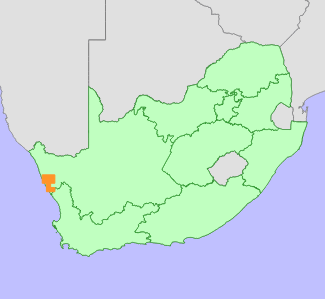|
Scientific Name | Dicrocaulon ramulosum (L.Bolus) Ihlenf. |
Higher Classification | Dicotyledons |
Family | AIZOACEAE |
National Status |
Status and Criteria | Least Concern |
Assessment Date | 2017/08/22 |
Assessor(s) | L. von Staden |
Justification | Dicrocaulon ramulosum is a widespread and common species that is threatened by habitat loss in places, but not yet in danger of extinction. It has an extent of occurrence (EOO) of 4 407 km², and is listed as Least Concern. |
Distribution |
Endemism | South African endemic |
Provincial distribution | Northern Cape |
Range | This species is endemic to Namaqualand, South Africa, where it occurs from Hondeklipbaai to Kotzesrus. |
Habitat and Ecology |
Major system | Terrestrial |
Major habitats | Namaqualand Heuweltjieveld, Namaqualand Strandveld, Namaqualand Heuweltjie Strandveld, Riethuis-Wallekraal Quartz Vygieveld, Namaqualand Klipkoppe Shrubland |
Description | It occurs in shallow soils with quartz pebbles and in granite outcrops. |
Threats |
| Dicrocaulon ramulosum is threatened by habitat loss and degradation due to open cast mining around Hondeklipbaai, and in other coastal areas further south. The main land use within its range is livestock grazing, and concerns have been raised over the impact of overgrazing and trampling on quartz field flora. Van Tonder et al. (2014) found that D. ramulosum disappeared from pathways trampled by livestock, but the population remained intact within wider grazed patches. Severe overstocking of quartz patches is therefore a potential threat to this species. |
Population |
This species is very common within quartz patches across its range, but particularly in the Riethuis-Wallekraal Quartz Fields (Schmiedel 2002). Although there are isolated threats across its range, the population is not suspected to be declining, but field monitoring is needed to confirm this.
|
Population trend | Stable |
Assessment History |
Taxon assessed |
Status and Criteria |
Citation/Red List version | | Dicrocaulon ramulosum (L.Bolus) Ihlenf. | Least Concern | Raimondo et al. (2009) | |
Bibliography |
Bolus, H.M.L. 1928-1935. Notes on Mesembrianthemum and allied genera. Part II. Bolus Herbarium, University of Cape Town, Cape Town.
Ihlenfeldt, H.D., Hartmann, H. and Poppendieck, H.H. 1978. Chromosome numbers in Mitrophyllinae Schwantes (Mesembryanthemaceae). Mitteilungen aus dem Institut für Allgemeine Botanik Hamburg 16:171-181.
Raimondo, D., von Staden, L., Foden, W., Victor, J.E., Helme, N.A., Turner, R.C., Kamundi, D.A. and Manyama, P.A. 2009. Red List of South African Plants. Strelitzia 25. South African National Biodiversity Institute, Pretoria.
Schmiedel, U. 2002. The Quartz Fields of Southern Africa: Flora, phytogeography, vegetation and habitat ecology. Unpublished PhD, Universität zu Köln, Köln.
Snijman, D.A. 2013. Plants of the Greater Cape Floristic Region 2: The extra Cape flora. Strelitzia 30. South African National Biodiversity Institute, Pretoria.
Van Tonder, C., Milton, S.J. and Cameron, M.J. 2014. Livestock paths on Namaqualand quartz fields: Will the endemic flora disappear? South African Journal of Botany 95:19-23.
|
Citation |
| von Staden, L. 2017. Dicrocaulon ramulosum (L.Bolus) Ihlenf. National Assessment: Red List of South African Plants version 2024.1. Accessed on 2025/11/17 |
 Comment on this assessment
Comment on this assessment


